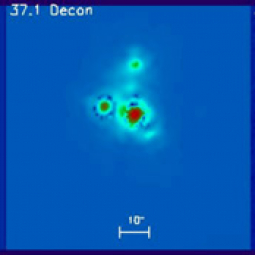Information about the star formation process, as well as early tests of the optical quality and stability of the telescope in NASA's Statospheric Observatory for Infrared Astronomy (SOFIA), were provided by analyses of infrared images of the Sharpless 140 nebula performed by Paul Harvey of the University of Texas at Austin with collaborators from Cornell University, Ithaca College, and the SOFIA scientific staff. The results of their work were published in a May 2012 special SOFIA-dedicated issue of The Astrophysical Journal Letters .
Infrared observations of the heart of the S140 star-forming region, 3,000 light years away in the northern sky’s constellation Cepheus, were made by Harvey and his colleagues.
The analysis presented by Harvey et al. in their Ap.J.Letters paper included use of special mathematical techniques called “super-resolution” to improve the sharpness of the SOFIA images. Were it not for the already relatively high resolution resulting from the size of SOFIA’s telescope and its impressive stability as an airborne platform, the “super-resolution” algorithms would have had no useable 'grist' to mill. Those analyses showed that SOFiA's angular resolution in the mid-infrared is more than sufficient for the observatory to support frontier scientific research.
The most significant SOFIA S140 images were obtained at a wavelength of 37 microns. Emissions from newborn massive stars in this nebula are strongest at that wavelength, but are also completely blocked for reception even by observatories on high mountains due to water vapor in Earth’s atmosphere. Celestial radiation at 37 microns is in a “no-man’s land” between what astronomers refer to as the mid- and far-infrared bands, and is accessible only to space observatories and SOFIA. But, radiation at around that wavelength is the dominant output of objects with temperatures near 100 Kelvin (300 degrees below zero, Fahrenheit), representing a crucial intermediate stage in the sequence of events leading to the formation of a star.
Harvey et al.'s SOFIA/FORCAST images of Sharpless 140 allow them to distinguish relatively warm infrared sources, presumably well along the way to becoming stars, from colder, less “evolved” objects, and from even colder, diffuse raw material that may one day form into stars.
Link to the Harvey et al. 2012 Ap.J.Letters article .
Link to a Spitzer Space Telescope image of a broader portion of S140; the region examined by SOFIA is within the bright zone near the center that is unresolved and ‘burned out’ due to the 3x smaller size of Spitzer’s telescope relative to SOFIA’s.

